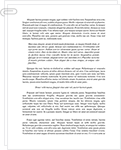 Study Document
Study Document
APRNs Can Do It All If Allowed Research Paper
Pages:4 (1199 words)
Sources:3
Document Type:Research Paper
Document:#99116304
Advanced Nursing and Shared PerspectivesCompetent healthcare requires a nursing workforce that is trained and qualified to meet the needs diverse patient populations. Advanced Practice Registered Nurses (APRNs) are important because they have specialized skills and knowledge and meet the requirements to be able to provide care that lesser educated nurses do not. The distinct roles of APRNs include Nurse Practitioners (NPs), Clinical Nurse Specialists (CNSs), Nurse Anesthetists (CRNAs), and Nurse Midwives (CNMs). They all cater to unique aspects of patient care, but overall APRNs bring advanced clinical training and leadership, which is why they have the scope and practice to act autonomously if permitted by state law, or in collaboration with other healthcare professionals in primary, acute, and specialty care. Each role is distinguished by its ability to diagnose, treat, prescribe, and manage independently patient care. This sets them apart from registered nurses (RNs) who typically operate under the supervision of doctors.Differences Between Advanced Nursing Practice and APRNsAdvanced nursing practice and APRNs differ in terms of the education they receive, the scope of their practice, and the responsibilities they are allowed to take on. Advanced nursing practice is a generalized reference to all nurses who have acquired post-graduate education. They could be nurse educators, administrators, researchers. APRNs, on the other hand, are a category of advanced nursing practice with specific clinical roles in direct patient care. Nurse Practitioners (NPs) provide primary care like what physicians used to solely provide before so many of them left for specialty practice. NPs can also work in specialty care, but they originated to fill the gap left by doctors leaving primary care (Fraze et al., 2020).APRNs can diagnose and treat patients; they can prescribe medications; they can do routine check-ups. CNSs are expert consultants who can educate staff nurses on improving healthcare delivery systems with specialized practice. CRNAs specialize in anesthesia care. They are role players in surgical, obstetric, and trauma settings. CNMs give care to women, including gynecological exams, prenatal care, delivery, and postpartum care. Specialized areas define the advanced nursing practice.Appraising the Population Served by Advanced Nursing Practice RolesEach APRN role may serve different patient populations. NPs tend to have the broadest role and serve all kinds of patients as they tend to be primary care providers or work with primary care providers. They may treat patients with chronic conditions, acute illnesses, or those who can benefit from preventative care. Or they…
…full scope of ones training. Some states grant full practice authority and allow APRNs to operate independently of physicians, but other states do not and require APRNs to have physician supervision or collaborative agreements. APRNs need to know their states regulations in order to practice safely.Collaboration Among APRN DisciplinesCollaboration among APRN disciplines helps with being able to deliver comprehensive care coordinated with other professionals. Examples include NPs and CNMs working together in providing care to pregnant women, so that there is continuity of care between prenatal and postpartum care stages. CNSs and CRNAs can work together in surgical settings to manage pain. NPs and CNSs can collaborate in primary care to manage chronic conditions. Collaborations of this sort are important for healthcare to be person-centered and holistic.ConclusionAdvanced nursing roles, particularly those of APRNs, are needed because of the way the healthcare system is today: they help to improve access to care to the wider public and provide specialized care in different roles. The differences between advanced nursing practice and APRNs underscore the specialized skills APRNs bring to clinical settings. Through rigorous certification processes, state-specific practice considerations, and collaborative efforts, APRNs are well-equipped to address diverse patient needs and contribute to a…
Related Documents
 Study Document
Study Document
Aprn
1. The Role of the Advanced Practice Registered Nurse (APRN) in Primary Care: This essay will explore the vital contributions of APRNs in primary care settings, including their impact on patient outcomes, the expanding scope of practice, and the challenges and opportunities presented by their growing role in healthcare delivery. 2. The Evolution of APRN Education and Certification Standards: Discuss the historical developments in APRN education and how rigorous
 Study Document
Study Document
Aprn
1. The Evolving Role of Advanced Practice Registered Nurses (APRNs) in Healthcare: This essay would explore how the role of APRNs has changed over time in response to shifts in healthcare demands, including the impact of legislation, the expansion of responsibilities, and the growing need for primary care providers, especially in underserved areas. 2. Full Practice Authority: Analyzing the Benefits and Challenges for APRNs: This topic would discuss the
 Study Document
Study Document
The Importance of Uniformity of Licensing of Aprns
Consensus Model The question of why the Consensus Model was developed in the first place is a worthy first point to make in this paper. The number of advanced practice registered nurses (APRNs) has greatly grown in numbers over the past twenty to thirty years in the United States. The healthcare system in America needed the skills and experiences of these nurses, not just because the APRNs had more education and
 Study Document
Study Document
Health Inequality and APRN Advocacy
Healthcare InequityHealthcare inequity refers to the gap between those who receive care they need and those who do not and that this difference is unfair (Artiga et al., 2020). The distinction between equity and equality refers to different approaches in healthcare. Equality involves providing the same resources and opportunities to everyone, and equity refers to how resources are allocated so as to have an equal outcome (health) for all (Lewis
 Study Document
Study Document
Healthcare Policy Aprns Reducing Cost
ABC/123 Version X Institutional Policy Analysis Policy Type Summary of the Policy (in your own words) Explain if the policy is effective and provide a rationale Describe the financial outcomes of the policy Provide examples of policy violations National APRNs' ability to practice is determined on a state-by-state basis, there is no specific policy in regards to practice scope (Kleinpell et al. 2014). Given that nurses are credentialed on a state versus a federal basis and the healthcare system
 Study Document
Study Document
Role of an Advanced Practice
In other words, physicians authorize the nurse practitioner to prescribe certain medications -- perhaps not all but those medications that are most often required by patients -- without getting approval from a physician. It saves time and is primarily designed to make the patient more comfortable, not just to hand additional authority to the nurse practitioner. Is prescriptive authority appropriate? This question, according to Patricia Berry, a faculty member at




